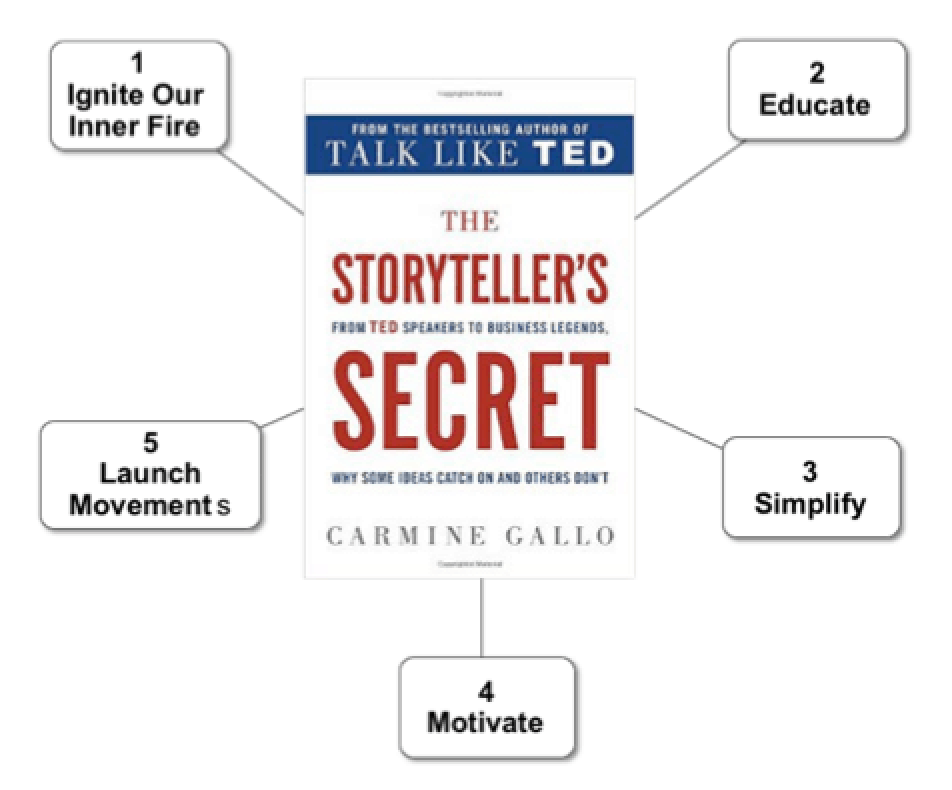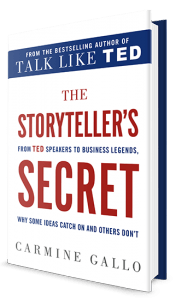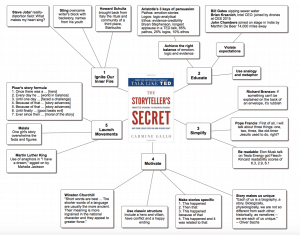
Storytelling Is Who We Are: The Storyteller’s Secret

The Storyteller’s Secret
“Storytelling is not something we do. Storytelling is who we are.” So begins The Storytellers Secret, a new book by Carmine Gallo that debuted yesterday.
“Ideas that catch on are wrapped in story,” Gallo says. “Your ability to communicate a compelling story that wins hearts and minds is the single greatest skill that will make you more successful than you’ve ever imagined.”
This book might be the best $28 investment you’ll make in your marketing message this year.
It rounds up stories from great storytellers of the past and present – Steve Jobs, Howard Schultz, Bill Gates, John Chambers, Richard Branson, Elon Musk, Pope Francis, Martin Luther King, Malala and many more. It shares not only their stories, but also the lessons you can learn from great storytellers.
“Above all, they are dream makers,” Gallo writes. “Some make us laugh. Some make us think. Some make us change.”
Gallo focuses on lessons learned from 5 types of storytellers: those who ignite our inner fire, educate, simplify, motivate and launch movements.
First are stories about igniting your inner fire. Three examples:
Steve Jobs was famous for storytelling abilities so incredible that they were described as his “reality distortion field.” But the foundation of Jobs’ stories was built by asking himself one key question: What makes my heart sing?
A story about singer-songwriter Sting sheds light on his prolonged case of writer’s block. After years of writing songs for The Police and his solo act, the tap ran dry. Sting eventually started writing again by making a simple list of the names of people he’d known in childhood. Tapping into his backstory helped him bring his writing back to life.
Howard Schultz of Starbucks was a junior employee sent to Italy to learn the coffee business. He came back home with the conviction that Starbucks was in the wrong business. But the owners disagreed, so Schultz went to work in another coffeehouse. After years of struggle, Schultz started his own coffee shop, bought Starbucks from its owners and began to realize his vision: importing from Italy the ritual and community of a “third place.”
In the second section of his book, Gallo shares stories that educate.
A key to education is to achieve the right balance of emotion, logic and evidence. Aristotle taught 3 keys to persuasion:
- Pathos: emotion and stories
- Logos: logic and analysis
- Ethos: evidence and credibility.
For centuries teachers taught that logos, logic and analysis, was the key to persuasion. It turns out, that’s all wrong.
Take for example, the TED talk that evoked the longest applause ever given to a speaker, Bryan Stephenson.
Gallo analyzed the talk line by line. It turns out that the most successful TED talk ever was two-thirds stories – 65% pathos, 25% logos and 10% ethos.
Stories can get lost in the clutter, but when they violate expectations, they break through. Examples: Bill Gates sipped sewer water to demonstrate a new water purification device. John Chambers was joined on stage in India by an executive 14,000 miles away via lifelike Telepresence. And during his speech at the 2015 Consumer Electronics Show, Intel CEO Brian Krzanich was joined on stage by 3 flying drones.
Analogies and metaphors educate audiences too. They simplify the complex.
Third, the book focuses on storytellers who simplify for their audiences.
As Virgin founder Richard Branson says, “If something can’t be explained on the back of an envelope, It’s rubbish.”
Pope Francis shares the secret of his masterful storytelling, “First of all I will talk about three things: one, two, three, like old-timer Jesuits used to do.”
Gallo notes that Tesla founder Elon Musk uses very simple language. Analyzing Musk’s talk to introduce Tesla Energy, Gallo finds its readability at a sixth-grade level. Speaking at that level is how Musk makes alternative energy sound easy to understand.
Fourth, Gallo shares stories from storytellers who motivate.
He cites Oliver Sacks, author of The Man Who Mistook His Wife for a Hat and Other Clinical Tales. Sacks points out, “Each of us is a biography, a story. Biologically, physiologically, we are not so different from each other; historically, as narratives – we are each of us unique.”
The book argues for the classic story structure, including a hero and villain, a conflict and a happy ending. To make stories believable, he advises making stories as specific as possible:
- This happened …
- Then that …
- This happened because of that …
- This happened and was related to that.
Winston Churchill argued eloquently for simple speech. “Short words are best. The shorter words in a language are usually more ancient. Their meaning is more ingrained in the national character and they appeal to greater force.”

Fifth, Gallo shares stories of people who launched movements.
He shares the backstory behind Martin Luther King’s most famous line, “I have a dream.” It turns out that those words never appeared in the prepared text of King’s speech.
But as King spoke, gospel singer Mahalia Jackson cried out, “Tell ‘em about the dream, Martin!” She inspired King to his famous use of anaphora, repeating the words I have a dream again and again to amplify his vision for an America that transcends racism.
The book shares the story of Malala, one Pakistani girl who stood up for the education of all girls and was shot by extremists for sharing her beliefs.
Later, Malala spoke at the United Nations to draw attention to the plight of the millions of girls around the world who can’t get an education. She wrote the book I Am Malala.
In December 2014, Malala became the youngest recipient ever of the Nobel Peace Prize, at 17. Her message was: “One child, one teacher, one book and one pen.” All the statistics in the world can’t match the energy of Malala’s compelling message.
Finally, Gallo shares the story formula used by Pixar. Here it is:
- Once there was a … [hero]
- Every day he … [inhabited a world in balance]
- Until one day … [he faced a challenge]
- Because of that …
- Because of that …
- Until finally … [good beats evil]
- Ever since then … [the moral of the story].
In The Storyteller’s Secret, you’ll find many useful ideas for telling your company’s story and crafting your business message. In the back, the book includes valuable resources such as storyteller’s secrets at a glance and a storyteller’s checklist.
The book challenges us to do as Joseph Campbell once said. “If you’re going to have a story, have a big story, or none at all.”
“What do storytellers do?” Gallo asks. “According to Walt Disney, they ‘instill hope again, and again, and again.’”
Related Posts
Why your business message needs a message map
I love business message maps. They help you find out where you are, decide where to go, and figure out how to get there. ...
Top 10 Blogs on Content Marketing
“Where can I learn more about content marketing?” In my workshops, marketers frequently want to learn more about how to make their content marketing...
How to change boring content into brilliant content
When content seems boring, often it’s because the content is too abstract. To get readers to sit up straight in their chairs, spice up...
Who’s The Hero In Content Marketing?
The roots of content marketing go back to Ben Franklin, and they spring from the oral tradition of storytelling. Who’s the hero in your...





